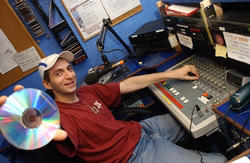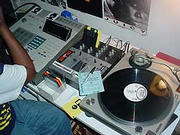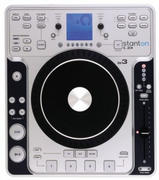DJing Techniques
Essential DJ tricks
Behind the groovy music played at parties, it requires on the part of a DJ to work hard for achieving desired effects.
Phasing...
Phasing describes relative phase shift in superposing waves. Waves may be of electromagnetic (light, RF), acoustic (sound) or other nature. By superposing waves using different phase shifts the waves can add (0° shift = "in phase") or cancel out each other (180°). A modulation of the relative phaseshift while superposing waves thus causes an amplitude modulatuion.
Phasing can be used as an audio effect. The term was often used to refer the original tape flanging effect heard on many psychedelic records of the late 1960s, notably Itchycoo Park by the Small Faces. However, as more practical solid-state electronics and latterly software were used to re-create an approximation of the unwieldy tape-flanging set-up, the term Phasing more specifically refers to a swept comb-filtering effect where there is no linear harmonic relationship between the teeth of the comb. (Compare this with flanging, where the teeth of the comb-filter are spaced along the frequency spectrum in a linear harmonic series.)
The electronic phasing effect is created by splitting an audio signal into two, electronically shifting the phase of one signal (usually by passing it through an allpass filter), and then recombining the two signals. The allpass filter passes all frequencies unchanged in amplitude, but has a frequency-dependent, non-linear effect on the phase of each frequency. The result is a signal whose overall spectrum is shifted by various amounts at each frequency. For example, the phase of a frequency at the low end of the spectrum may be shifted by 1/4 of a wavelength, while a frequency at the high end of the spectrum may be shifted by 3/4 of a wavelength.
When the filtered and non-filtered signals are recombined, the phase differences between them now cause peaks and notches of reinforcement and cancellation along the frequency spectrum (the so-called comb filter pattern). The degree of phase shift is periodically modulated (usually using an LFO), causing the peaks and notches to 'sweep' up and down the frequency spectrum, producing the characteristic rolling timbral changes of the phasing effect.
A phaser is an electronic device used to produce this effect. It was originally produced by simply copying the sound onto two analogue tape decks and mixing them together with one tape running slightly faster than the other, so that one copy of the sound would overtake the other, resulting in a rising then falling effect caused by wave interference.
In motion picture or television production, the effect created by a phaser is often used to imply that the sound is synthetically generated (e.g. a computer or robot voice). The technique works because the frequency filtering produces sound we associate with mechanical sources, which only generate specific frequencies, rather than natural sources, which produce a range of frequencies.
Beat juggling...
Beat juggling is the act of manipulating individual drum beats, or vocal phrases, in order to make a composition, using multiple turntables and one or more mixers. This can involve pauses, scratching, breaks and delays. It could be seen as fingertip sampling, and the turntable and mixer combination could be seen as an instrument from which sounds are made, from the sounds of other instruments (samples).
Beat Juggling has its roots in cutting, in which a small section of a beat is looped using two copies of the same record. This was first done by Kool DJ Herc, and later refined by DJs such as Grandmaster Flash in the early 80s.
Steve Dee is generally credited with inventing what we now call Beat Juggling. Referring to it simply as "The Funk", he took cutting to a whole new level - effectively making his own beats from reconstructed parts of other songs. The technique was refined by the DJ group The X-Men, who later became The_X-Ecutioners.
Beatmatching...
Beatmatching is a mixing technique employed by DJs that was popularized by Francis Grasso in the late 60's/early70's. While originally it involved counting the tempo with a metronome and finding a record with the same tempo, today it involves changing the speed at which a recording is played back so that its tempo matches that of the song currently playing. In this way, the DJ can either simultaneously play two songs of different original tempos without their beats clashing or "galloping" or can more smoothly transition between two songs. The tempo of the recording can be changed through the use of specialized playback mechanisms. In the case of vinyl records, for example, the turntable would have a separate control for determining the relative speed (typically listed in percent increments) faster or slower the record can be played back. Similar specialized playback devices exist for most recorded media. Changing the speed the record is playing is called pitching or pitch shifting.
For a DJ wishing to beatmatch using vinyl turntables, the general procedure involved is relatively simple to explain, but harder to master.
Assume, as is the case for most DJs, that we have two turntables with records on them, T1 and T2, and a mixer capable of variably blending the outputs of T1 and T2, and also allowing the DJ to cue the music playing on one or other of turntables (listen to it on headphones without outputting the sound to the audience). In order to control the records on the turntables, the DJ must be competent in moving the vinyl record with his hand whilst the platter of the turntable is moving. Typically a slipmat is placed on the turntable between the record and the platter, to reduce the friction between the two, and allow the DJ to search through a record by moving it with his or her hand, as well as momentarily speed up or slow down the record, by pushing/nudging it on, or holding it back (typically by pressing a finger against the side of the turntable platter to reduce its speed).
Now, if T1 is playing to the audience, and we wish to mix the beginning of T2 into the closing sections of T1, we will most likely need to adjust the pitch of T2 in order to match the tempos of the two songs, and the beats.
To do this, the first thing a DJ must do is find the start of the beat in T2. For a lot of dance music, this is typically the first sound of the song, often a kick drum. The DJ can find this beat by playing the record until he hears the sound of the first beat in his headphones, which will be set to cue T2. Once the first beat has been found, the DJ can hold the record with his hand and prevent it from spinning, thus pausing the sound. To start it again, he or she must simply release the record, and the spinning platter will start the record moving again. To find the first beat again once the song has begun playing, the DJ can rewind the record, again with his or her hand. In this way it is possible to start T2, rewind it, start it again, etc... Once the DJ is confident he or she has found the first beat, and can start it at the exact moment they desire, the process of beatmatching can begin.
The basic process is as follows:
Hold T2 on its first beat (the DJ hears it through headphones, the audience cannot).
Listen to T1, and try to follow the beats to a bar (i.e. know which is the first beat of the bar).
Start T2 on the first beat of a bar (ideally this will be the first bar of a section of T1, see below). Assuming the tempos of T1 and T2 are close, the two tracks will sound 'in time' to begin with.
If the tempo of T2 is too slow, it will fall behind T1 (listening to the drums often highlights this). If this is the case, speed up T2 (see above) until it is again in time with T1.
If the tempo of T2 is too fast, it will overtake T1 (again, the drums are often the easier way to hear this). If this is the case, slow down T2 (see above) until it is again in time with T1.
Repeat this process until you are sure that T2 is definitely slower or faster than T1.
Now, once we know if T2 is too fast or too slow, we can permanently adjust the pitch using the pitch slider (found to the side of all DJ turntables) to adjust the tempo of T2 and bring it closer to that of T1.
Next we must repeat the whole process of testing T2 to see if it is too fast, too slow, or just right to blend with T1, and adjusting as necessary.
After a few iterations of this procedure (the speed at which it is performed varying according to the skill of the DJ) the tempo of T2 should be very close to that of T1. If this is so, the DJ will find that even after listening to T2 for a (relatively) long time, it will not fall out of time with T1. At this point we can be sure our beats match, and T1 and T2 are at close enough speeds that they may be blended. Now we can simply start T2 at the desired point in T1 to create a nice effect, layering the outro of T1 over the intro of T2.
To beatmatch, a DJ must be aware of both the songs he or she wishes to blend at all times. A fact that makes the life of a dance music DJ a lot easier is that the majority of dance music is based around the 4/4 time signature. In broad terms, this has the effect that the sections of a dance music song will have length equal to some multiple of 4 bars. Most commonly, if you count the bars in a section of a song, they will be 4, 8, 16, 32, or 64 bars in length. This information helps the DJ decide at which point during T1 he must start T2 in order for the sounds of one track to fade as the other builds, or whatever effect is desired.
Cutting (music)...
In hip hop music, cutting is a disc jockey technique, originated by DJ Grandmaster Flash, which is "manually cueing up duplicate copies of the same record in order to play the same passage, cutting back and forth between them." (AMG) This is necessary to isolate and extend breaks into breakbeats.
Also a term from the days of vinyl records. To "cut a record" was to record a record because the grooves in the orginial acetate were physically cut according to the music.
Scratching...
Scratching is a DJ or turntablist technique originated by Grand Wizard Theodore, an early hip hop DJ from New York (AMG). The technique is designed to accentuate the work of the DJ by creating an assortment of sounds through the rhythmical manipulation of a vinyl record, and has spread from hip hop culture to a number of other musical forms. Within hip hop culture, scratching is still of great importance in determining the skill of a DJ, and a number of competitions are held across the globe in which DJs battle one another in displays of great virtuosity.
A simple (or baby) scratch is performed by moving a vinyl record back and forth with your hand while it is playing on a turntable. This creates a distinctive sound that has come to be one of the most recognizable features of hip hop music. Ideally, scratching does not damage a record because the needle stays within the groove and does not move horizontally across the record's surface. Theodore developed scratching from DJ Grandmaster Flash, who describes scratching as, "nothing but the back-cueing that you hear in your ear before you push it [the recorded sound] out to the crowd." (Toop, 1991) Kool Herc was also an important early figure.
There are many different types of scratch, including tear, flare, orbit, twiddle, crab, tweak, chirp, and scribble scratches. The names can indicate the scratch's sound, required hand motions and equipment set up, or the name of the DJ who developed it. Recently, DJs and turntablists have begun developing systems of notation for use in learning different scratches and writing compositions. The practice is not yet widespread.
Sounds that are frequently scratched include but are not limited to drum beats, horn stabs, spoken word samples, and lines from other songs. Any sound recorded to vinyl can be used, though a new generation of CD players providing a turntable-like interface has recently reached the market, allowing DJs to scratch not only material that was never released on vinyl, but also field recordings and samples from television and movies that have been burned to CD-R. Some DJs and anonymous collectors release 12-inch singles called battle records that include trademark, novel or hard-to-find scratch fodder. Some DJs prefer to rotate the turntable 90 degrees counter-clockwise in an orientation known as "Battle-style" to put the tonearm of the turntable at the top, furthest away from the DJ. This frees up more of the platter to manipulation without interfering with the needle.
Slip-cueing...
Slip-cueing is a DJ technique originated by Francis Grasso that consists of "holding a record still with his thumb and forefinger while a protective slipmat and the steel platter of the turntable revolved underneath. He then released the vinyl at the exact right moment he wanted to come in with the new song, creating a sudden segue from the previous track, similar in the beats-per-minute range and orchestration." (Jones and Kantonen, 1999)
"Francis was the first DJ to perfect the current technique for stitching records together in seamless sequences. He invented the trick of "slip-cuing"; Holding the disc with his thumb while the turntable whirled beneath insulated by a felt pad, he would locate with an earphone the best spot to make the splice, then release the next side precisely on the beat. When he got Thorens turntables with speed controls, he supplemented his cuing technique with speed changes that enabled him to match up the records perfectly in tempo (segue)." (Goldman, 1978)


